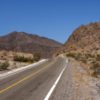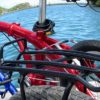The non-traditional way we plan to carry all of our gear

Since we first announced our biking scheme, we have been asked multiple times how we plan to carry all of our gear. Most people have seen cycle tourers before, if not in person, then at least in photos or on film, and almost always these people are found traveling on bikes designed to carry a large load, and that are fitted out with panniers, front and rear, to carry all of the traveler’s possessions. Occasionally they are also seen towing a trailer. Because of our goal of traveling lightly, and off road as much as possible, neither of those are exactly what we envision.

Tumbleweed Prospector fitted out with bikepacking gear.
Our goal
Rebecca and I have an image of how we’d most like this next phase of our adventure to pan out. The picture in our minds has been inspired by the travels of many others who have done similar trips, and it looks like this:
To travel and explore the length of the Americas, following the road less travelled (note the Frost reference), avoiding high-traffic paved roads as much as possible. We’d like to travel as minimalistic as possible, carrying all our own gear, and to spend our nights either camping, or with friends along the way. We’ll travel as much as we want each day, putting in miles when we choose to, but also stopping to smell the roses when the urge strikes us.
That’s our goal anyway.

What’s old is new again.
There is a category of cycling called bikepacking, and while perhaps that term and some of the gear associated with it is relatively new, I don’t think the approach is all that radical. If you don’t believe me, check out these vintage images that I dug up on the web!
Backpacking.com describes it as follows:
Simply put, bikepacking is the synthesis of mountain biking and minimalist camping; it evokes the freedom of multi-day backcountry hiking, with the range and thrill of riding a mountain bike. It’s about forging places less travelled, both near and afar, via singletrack trails, gravel, and abandoned dirt roads, carrying only essential gear. Ride, eat, sleep, repeat, enjoy!
The most significant gear innovation that has helped popularize bikepacking is the commercial availability of bike-specific soft bags. Replacing traditional racks and panniers, these consist of a framebag, a handlebar bag or harness, a seat pack and peripheral bags. Light, rattle free and tailored to modern mountain bikes, they’ll optimize your bike’s carrying capacity without adding significantly to its weight, or effecting the way it handles.
There is a ton of info on the bikepacking.com link. Do check it out!
The one tiny hurdle to overcome
The most significant hurdle to this approach, as observed from inside our boat at anchor in Martinique, will be the initial Alaskan stretch from Deadhorse to Fairbanks. From what we have read, there is only one spot to re-provision along that 800 km road, necessitating that we carry a significant amount of food, along with all of our other necessities. For this reason, we anticipate that at least one of us will need to have a rack and a couple of small panniers, but if so, we may end up leaving them in Fernie at Rebecca’s sister’s house as we pass through.
The one advantage that we have is that we’ll be traveling as a team, and thus can split up the load. You know how that goes, right? Rebecca carries the heavy tent, I carry a pillow. Rebecca carries all the cooking gear, I carry the other pillow. 😉

Daniel with prototype Tumbleweed with bikepacking setup and small panniers. Photo by Cass Gilbert.






I’d imagine a small backpack could be utilized also. You know, for an extra pillow.
Some people do you backpacks, but most of the rider shun them. The idea is to let the bike carry the weight. We’ll each have a small lightweight backpack with us though, to be used for dayhikes, and for short provisioning runs.
When you travel through Colorado we are happy to bring you anything you need. For example you could ship us things ahead of time that you want for that portion of the trip (fresh clothes, etc.) and we can bring them to you, take what you no longer need and ship it to wherever you want us to.
Thanks, Sue. We may very well take you up on that offer! 🙂
Hey Mike and Rebecca, Glad to hear you guys are exited to roll. I’m looking forward to following you on your new adventures. Are you going to continue to report? Will it be called Zero to Wheels ? or Zero TWO Wheels ?
All the best,
Ross in NY (colder than Alaska)
Hi Ross
yes, we will continue to write, as much as mountain and jungle internet will permit.
As for the name, I wrote this in a comment 3 days ago:
We have decided, at least in our own minds, that the word cruising does not solely imply boat travel. As such, and since we’re starting over once again, the name will remain the same.
cruise (kro?oz)
v. cruised, cruis·ing, cruis·es
v.intr.
1.
a. To sail from place to place, as for pleasure or reconnaissance.
b. To go or move along, especially in an unhurried or unconcerned fashion: “A car, a long closed car that maybe was a Packard, came slowly down the street, and … cruised close to the curb” (Carson McCullers).
2. To travel at a constant speed or at a speed providing maximum operating efficiency for a sustained period.
3. Informal To move leisurely about an area in the hope of discovering something: taxis cruising for fares.
v.tr.
1. To travel about or journey over.
I had one of those under the seat bags and hated it. You might want to test drive that. I prefer small panniers. For one thing, they are a god send when you need to stack stuff. And you will at some point.
* Stove and pots/tableware
* Fuel
* Sleeping bags
* Sleeping pads
*Tent
* Water
* Food
* Foul weather clothes
* Other clothes, shoes, hats, gloves, sun glasses… and so forth
* Tools and spares
* First aid, meds, soap etc. Hygiene matters, riding every day. I’ve done that.
* Towels
* Back pack (one of the bags can convert)
* Bug spray
and things you added:
* Bear spray
* Rope to hang food
I know this can be squeezed–climbers learn all the trick–but still, I have my doubts, unless you plan a lot of resupply stops. I love the idea of light, but reality catches up, given the range of weather, terrain, and remoteness. Tiny items add up.
We have spent a lot of time studying the packing lists of people doing this. There is definitely a balance between comfort and light weight, and from what I have seen, it gets adjusted frequently. What I see most often is people packing up stuff to send “home,” things they realize that they don’t actually use or need. I would ideally like to begin the opposite way, as minimalist as possible, and then when we decide that we need something more, we can buy it.
As for the seatpack, what specifically didn’t you like about it?
I like the weight lower.
I suspect the real answer is that you will change not only the gear but also how you carry it according to needs. As you have said, it will be a learning process. For such a trip, with so much variety, how could there possibly be only one answer?
Fascinating.
That is absolutely true. I’m sure it will change.
This is so exciting! Me and my husband definitely want to do this in the future.
Is that right? Cool!
Mi Mike, where will the laptop fit? We need updates! Or maybe its time to update the site from a Phablet?!
We have an iPad mini, and while I have used it for blog updates in the past, it is very cumbersome to do so though. For this reason I’ll be bringing my Macbook Air. It’s not much bigger than many full-size tablets, and quite light and robust too.
No mudguards?
We’ll cross that bridge when we get the bikes because yeah, there will be mud!
Maybe this is just expedient wording, but I would not consider any spots north of Fairbanks to be appropriate for (re)provisioning. You will need to be fully provisioned before heading north as there is nothing in Deadhorse that can be described as a supermarket or grocery store. Think of a gas station convenience store and you aren’t far from what’s up there.
Along the way, there is the occasional restaurant but no places where you can resupply with real food. One in Coldfoot with a buffet, at the Yukon River where you can get some damn good cheeseburgers and chili, and a truck stop just uphill from Fox, but you’re so close at that point that you may choose to just have a piece of pie and press on to Fairbanks. I think there are maybe a couple smaller, easy to miss restaurants that might be open or not depending on season/economy/etc.
Having just done some of the Baja Divide with bikepacking gear and going on the occasional winter bikepacking trip up here, I can give some opinions if you’d care to hear.
Thanks, Ben. I’d love to hear what you have to say!